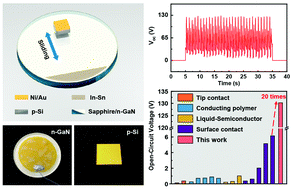Achieving an ultrahigh direct-current voltage of 130 V by semiconductor heterojunction power generation based on the tribovoltaic effect†
Abstract
The tribovoltaic effect can generate direct-current (DC) from the friction between semiconductor heterojunctions, and has aroused worldwide attention recently. However, the low output voltage and power have been restricting the practicability. Here, we propose a semiconductor DC triboelectric nanogenerator (SDC-TENG) with ultrahigh voltage and power density using the gallium nitride/silicon (GaN/Si) heterojunction. The maximum DC voltage is up to 130 V, which is an enhancement of about 20 times compared with the reported semiconductor TENGs. The peak power density can reach 2.8 W m−2, which is nearly 46 times that of previous semiconductor TENGs at the centimeter-level. The SDC-TENG can maintain high output voltage at different speeds, as well as great durability for over 20 000 cycles. Additionally, compared to the traditional polymer TENG at the centimeter-level, the SDC-TENG showed greatly enhanced performances in the open circuit voltage, transferred charge density per cycle (23 mC m−2) and average power density (1.5 W m−2). Instead of a high voltage source, the SDC-TENG can successfully drive a commercial light bulb and piezoelectric bimorph. This work set a voltage record for the tribovoltaic effect, which is expected to be a semiconductor based high voltage DC power supply from frictional energy dissipation in the future.



 Please wait while we load your content...
Please wait while we load your content...